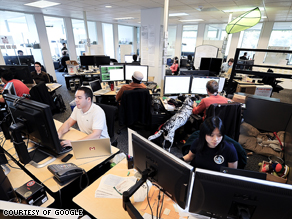Gmail's 5 second Undo Send. (yawn)
 Wed, March 25, 2009 at 3:27 PM in
Wed, March 25, 2009 at 3:27 PM in  Disruptive Technology
Disruptive Technology  If you're a gmail user you've now got some new functionality. Undo Send (when enabled) gives you a popup for 5 seconds before it sends the email, theoretically giving you time to prevent your email from being sent with a typo or missing attachement.
If you're a gmail user you've now got some new functionality. Undo Send (when enabled) gives you a popup for 5 seconds before it sends the email, theoretically giving you time to prevent your email from being sent with a typo or missing attachement.
Yawn.
CNN is so smitten with this feature and other gmail trivia like "Mail Goggles" (to help users stop sending "mail you later regret) that it's featured at the top of the technology section:
"Undo Send" is also just the latest example of the dozens of creative -- and sometimes downright wacky -- online features developed at Gmail Labs to address common e-mail problems.
The number of lab features has more than tripled, to more than 36, as Gmail celebrates its fifth birthday next week.
Of course, that other shoe dropping you hear is that this doesn't actually 'Undo' anything. It simply inserts a 5 second timer after you click send before Gmail actually sends your email. That's it. Not to much going on behind the curtain and you won't need a team of crack engineers to develop functionality like that. It's like trying to build a spaceship with paddle-wheel boat technology.
Now call me prejudiced but I'm going to draw a few comparisons between Gmail's 'Undo Send' and Sendsides' feature, 'Recall' that's enabled with every account.
First, Gmail's Undo Send; Inserts a popup window for 5 seconds before your email is actually sent.
Next up; Recall. Sendside's Recall feature allows you to retract any message or file at any time after it's been sent... or delivered, or read, or forwarded.
Sent it yesterday? Fine. The recipient's allready read it? No problem. It's been forwarded? Yep. In fact, you can see who it's been forwarded to and if they've opened it, when, and every time they've looked at or downloaded your attachment.
Sendside's functionality is so far beyond what gmail is developing it's unreal. Of course, Google's at a severe disadvantage since Gmail is built on the same SMTP protocols that were implemented in 1982 and haven't changed since then. It won't always be that way of course. Individuals and businesses want to be able to really recall and control their content, see when they're message is read, and stop hassling with email workarounds.
Email won't be dislodged easily. It has 100% market penetration and works perfectly well for telling your wife you'll be home late for dinner.
Of course, the horse and buggy had 100% market penetration at one time too.


